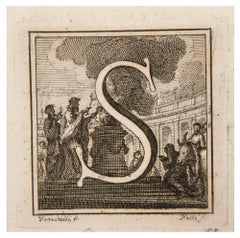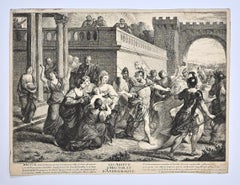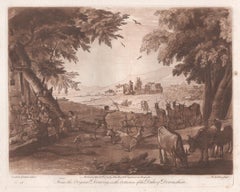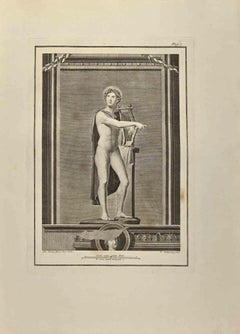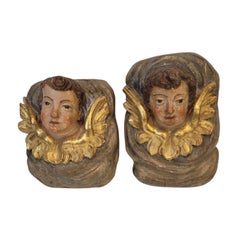18th Century Art
to
572
3,373
1,085
377
241
301
Overall Width
to
Overall Height
to
7,534
21,280
158,729
232,795
1,969
2,237
4,912
6,411
5,806
13,274
19,657
25,624
18,276
13,568
5,378
2,283
1,164
42
15
8
2
1
2,726
2,166
370
3,159
1,575
1,078
901
850
705
613
442
414
382
318
271
256
185
170
155
143
127
124
119
3,178
1,226
895
775
455
160
127
86
81
72
1,230
3,066
3,381
838
Period: 18th Century
Letter S - Etching by Luigi Vanvitelli - 18th Century
Located in Roma, IT
Letter S is an Etching realized by Luigi Vanvitelli.
The etching belongs to the print suite “Antiquities of Herculaneum Exposed” (original title: “Le Antichità di Ercolano Esposte”)...
Category
Old Masters 18th Century Art
Materials
Etching
Still Life Garland of Flowers - Flemish 18thC art Old Master floral oil painting
By Pieter Casteels III
Located in Hagley, England
This superb 18th century Old Master floral still life oil painting is attributed to Flemish artist Pieter Casteels III. Painted circa 1730 it is a garland or swag of flowers, somethi...
Category
Old Masters 18th Century Art
Materials
Oil
$19,620 Sale Price
20% Off
Les Adieux d'Hector d'Andromaque - Etching by Jean Moyreau - 18th Century
By Jean Moyreau
Located in Roma, IT
Les Adieux d'Hector d'Andromaque is an etching realized by Jean Moyreau in the 18th Century.
Good conditions.
The artwork is depicted through soft strokes in a well balanced condit...
Category
Old Masters 18th Century Art
Materials
Etching
Italianate Landscape, mezzotint by Richard Earlom after Claude le Lorrain
Located in Melbourne, Victoria
Sepia mezzotint by Richard Earlom (1743-1822) After Claude Gellee ('Claude Lorrain') (1600-82).
From 'Liber Veritatis; or A Collection of Prints after the original designs of Claude le Lorrain...
Category
Italian School 18th Century Art
Materials
Engraving, Mezzotint, Etching
Apollo God With his Lyre - Etching by Pietro Campana - 18th Century
Located in Roma, IT
Apollo God With his Lyre from "Antiquities of Herculaneum" is an etching on paper realized by Pietro Campana in the 18th Century.
Signed on the plate.
Goo...
Category
Old Masters 18th Century Art
Materials
Etching
Pair of Angels Baroque Sculpture “Cherubim”, polychrome and gilded wood
Located in Valladolid, ES
One of a kind pair of cherub high reliefs dating from the 18th century, probably belonging to the Castilian school.
These are two rectangular high reliefs in carved, polychrome, an...
Category
Baroque 18th Century Art
Materials
Wood
Portrait of a Lady with a Blue Bow - British 18thC art Old Master oil painting
Located in Hagley, England
This superb British 18th century Old Master portrait oil painting is attributed to Matthew William Peters. Painted circa 1780 it is a fine half length portrait of a woman gazing to her left. She has a lovely blue bow and sash on her dress. The sympathetic detail in her face is sublime. A really wonderful 18th century Old Master portrait. Matthew William Peters was known for his late 18th century portraits which had both the influence of Sir Joshua Reynolds and Thomas Gainsborough.
Provenance. Lincolnshire estate.
Condition. Oil on canvas 30 inches by 25 inches unframed and in good condition. Has has restoration.
Frame. Housed in an ornate gilt carved swept period frame, 40 inches by 35 inches framed and in good condition.
Matthew William Peters (1742-1814) was an English portrait and genre painter who later became an Anglican clergyman and chaplain to George IV. He became known as "William" when he started signing his works as "W. Peters". Peters was born in Freshwater, Isle of Wight, the son of Matthew Peters (born at Belfast, 1711), a civil engineer and member of the Royal Dublin Society; by Elizabeth, the eldest daughter of George Younge of Dublin. The family moved from England to Dublin when Peters was young. Peters received his artistic training from Robert West in Dublin; in 1756 and 1758 he received prizes from the first School of Design in Dublin. In 1759, he was sent by the Dublin Society to London to become a student of Thomas Hudson and won a premium from the Society of Arts. The group also paid for him to travel to Italy to study art from 1761 to 1765. On 23 September 1762 he was elected to the Accademia del Disegno in Florence. Peters returned to England in 1765 and exhibited works at the Society of Artists from 1766 to 1769. Beginning in 1769, Peters exhibited works at the Royal Academy. In 1771 he was elected an associate and in 1777 an academician. He returned to Italy in 1771 and stayed until 1775. He also probably traveled to Paris in 1783–84, where he met Léopold Boilly, Antoine Vestier, and was influenced by the work of Jean-Baptiste Greuze. On 27 February 1769, Peters became a freemason, and he was made the grand portrait painter of the Freemasons and the first provincial grand master of Lincolnshire in 1792. In 1785, he exhibited portraits of the Duke of Manchester and Lord Petre as Grand Master at the Royal Academy exhibition. According to Robin Simon's article in the Oxford Dictionary of National Biography, no British contemporary had such an Italian manner of painting as Peters, reflecting the old masters he copied. Many of Peters' works were erotic and although these works did not damage his career, according to Simon, Peters later regretted these when he became an ordained clergyman in 1781. He served as the Royal Academy's chaplain from 1784 to 1788, at which time he resigned to become chaplain to the Prince of Wales. In 1784, Peters was awarded the living of Scalford, Leicestershire by Charles Manners, 4th Duke of Rutland. In 1788, the Dowager Duchess gave him the living at Knipton, at which time he also obtained that at Woolsthorpe. These livings were near to Belvoir Castle...
Category
Old Masters 18th Century Art
Materials
Oil
$6,758 Sale Price
20% Off
Hermes in Ancient Roman Statue - Original Etching by Carlo Nolli - 18th Century
By Carlo Nolli
Located in Roma, IT
Hermes in Ancient Roman Statue, from the series "Antiquities of Herculaneum", is an original etching on paper realized by Carlo Nolli in the 18th century.
Signed on the plate, on th...
Category
Old Masters 18th Century Art
Materials
Etching
Portrait of old woman
Located in Genève, GE
Work on canvas
Category
18th Century Art
Materials
Oil
$1,890
Chinese Diver, 18th century bird engraving by John Latham
By John Latham
Located in Melbourne, Victoria
Copper-line engraving. 1781. From John Latham's 'General Synopsis of Birds' 1781-1785, and its Supplements. Plate number top left. Laid paper.
John Latham was the leading English or...
Category
Naturalistic 18th Century Art
Materials
Engraving
Landscape See Paint Oil on canvas Flemish Old master 18th Century Italian Art
Located in Riva del Garda, IT
Flemish painter active in Italy in the eighteenth century
Coastal landscape of the Mediterranean with architectures and figures
Oil painting on canvas (69 x 88 cm., in frame 80 x 100 cm.)
The suggestive view proposed depicts a coastal view with a bay and the ruins of an ancient building, probably a monastery or a church, and in the background another building with a garden surrounded by high walls close to the shore.
The type of landscape, typical of the southern Italian environment, and the intimate atmosphere that welcomes the scene, attributes the authorship of the work to a landscape painter active in the eighteenth century, presumably in Italy in this period, with immediate references to the Dutch school , and in particular to the production of Jacob de Heusch and above all of Gaspar van Wittel, considered the progenitor of Italian landscape painting.
In fact, in the rendering of the architectural details, in the purity with which the buildings have been reconstructed, as well as in the atmosphere that encompasses the entire landscape, a marked correspondence to the so-called "Vanvitellian realism" can be seen: in fact, a comparison with a certain series of views which the Dutchman...
Category
Old Masters 18th Century Art
Materials
Oil
$7,094 Sale Price
20% Off
St. Paul shaking off the Viper in the Island of Malta
By Giovanni Paolo Panini
Located in London, GB
Literature:
cf. 'Catalogue of Paintings in the Wellington Museum Apsley House' by C.M. Kauffman, revised by Susan Jenkins, English Heritage in association with Paul Holberton publish...
Category
18th Century Art
Materials
Canvas, Oil
Portrait of Ann Austen, nee Grey
Located in London, GB
Signed 'BDandridge/ pinxit' lower left
Provenance
By descent through the sitter's family to
The Collection of R. W. Vivian-Neal of Poundisford Park, Somerset, from whom acquired by
With Lane Fine Art, UK, where purchased by the present owners in 1996
Literature
'Poundisford Park, Somerset' in Country Life, 22 December 1934, ill.
A.W. and C.M. Vivian-Neal, Poundisford Park, Somerset: A catalogue of pictures and furniture, Taunton 1939, cat. nos. 11 and 13
This is a portrait of Ann Austen, nee Grey, three-quarter-length seated in a landscape with her dog. Painted in a superb white satin dress, she holds horn spectacles and a spectacle case...
Category
English School 18th Century Art
Materials
Oil
William Payne (1760-1830) - 1798 Watercolour, Village By The River
By William Payne
Located in Corsham, GB
Signed to the lower left. Presented in a gilt frame with foliate detailing. On paper.
Category
18th Century Art
Materials
Watercolor
$542 Sale Price
20% Off
Portrait of a Lady
By Francesco Guardi
Located in Paris, Île-de-France
Francesco GUARDI (1712-1793)
Portrait of a Lady
Oil on copper
5 1/8 x 4 3/8 in
13 x 11 cm
Unsigned
Provenance
Private collection, France
We are pleased to present an exceptional...
Category
Old Masters 18th Century Art
Materials
Copper
Allegory Poetry Trémolières Paint 18th Century OIl on canvas Old master France
Located in Riva del Garda, IT
Pierre Charles Trémolières (Cholet, 1703 - Paris, 1739)
Allegory of Poetry (the Muse Calliope)
Oil on canvas (86 x 112 cm - In original lacquered frames 122 x 95 cm.)
Work ac...
Category
Old Masters 18th Century Art
Materials
Oil
$10,579 Sale Price
20% Off
ANTIQUE FRENCH GILT BRONZE FIGURE OF MARS
Located in Milan, IT
BRONZE FIGURE OF MARS, 18th Century
gilt bronze on marble base
35.6 x 8.9 x 7.6 cm
14 x 3 1/2 x 3 in
Category
18th Century Art
Materials
Marble, Bronze
A view of Paesteum with Grand Tourists in the foreground
Located in Stoke, Hampshire
Pietro Antoniani (Milan circa 1740-1805)
A view of Paesteum with Grand Tourists in the foreground
Oil on canvas
Painting Size 13 x 19 1/2 in
Framed Size 17 x 24 in
Provenance
Sale,...
Category
Old Masters 18th Century Art
Materials
Oil
Mother of Pearl Inlaid Wooden Occasional Table
Located in New York, NY
This occasional table is a remarkable example of the luxurious furniture popular during the 17th and 18th centuries in Colonial Latin America. The decorative technique that creates s...
Category
18th Century Art
Materials
Wood
Veduta della Basilica di S. Paolo Fuor delle Mura - Etching
Located in Roma, IT
Etching on laid and watermarked paper (a double circles visible near the bell tower). 38 th Plate from the series " Views of Rome".
Signed on plate on lower-left margin "Piranesi F....
Category
18th Century Art
Materials
Etching
Thomas Willis, MD, 17th C. Pioneer of Neurology & Psychiatry: 18th C. Portrait
Located in Alamo, CA
This is an 18th century copperplate engraved portrait of the 17th century physician and scientist Thomas Willis, MD from "The Heads of Illustrious Person...
Category
18th Century Art
Materials
Engraving
The Donkey - Etching by Pierre Charles Baquoy - 1771
Located in Roma, IT
The donkey is an etching realized by Pierre Charles Baquoy in 1771.
It belongs to the suite "Histoire naturelle, générale et particulière avec la description du Cabinet du Roi".
Pa...
Category
Modern 18th Century Art
Materials
Etching
Allegory Of Europe Solimena 18th Century Paint Oil on canvas Old master Italy
Located in Riva del Garda, IT
Francesco Solimena (Canale di Serino 1657 - Barra 1747)
workshop/circle
The Allegory of Europe
oil on canvas
102 x 76 cm. - with frame: 119 x 92 cm.
The work, which can be placed ...
Category
Old Masters 18th Century Art
Materials
Oil
$8,587 Sale Price
20% Off
Vintage Moth I (Made-to-order, Hand-Painted, Gold Luster, Vintage Imagery)
Located in Kansas City, MO
Melanie Sherman
Vintage Moth I (Hand-Painted, Gold Luster, Vintage Imagery)
Porcelain, Glaze, Overglaze, Chinapaints, 24k German Gold Luster
Year: 2025
Size: 4.5 x 6 x 0.5 inches
Sig...
Category
Victorian 18th Century Art
Materials
Luster, Porcelain, Paint, Glaze
La Mort de la Vierge (B99), Heliogravure by Rembrandt van Rijn
Located in Long Island City, NY
Rembrandt van Rijn, After by Amand Durand, Dutch (1606 - 1669) - La Mort de la Vierge (B99), Year: 1878 (of original 1639), Medium: Heliogravure, Size: 9.25 x 7.5 in. (23.5 x 19.0...
Category
Old Masters 18th Century Art
Materials
Etching
Le Paysage a la Vache qui sa Breuve (B237), Heliogravure by Rembrandt van Rijn
Located in Long Island City, NY
Rembrandt van Rijn, After by Amand Durand, Dutch (1606 - 1669) - Le Paysage a la Vache qui sa Breuve (B237), Year: 1878 (of original 1650), Medium: Heliogravure, Size: 4.25 x 5 in....
Category
18th Century Art
Materials
Etching
Cultivated Pea Plants: An 18th C. Hand-colored Botanical Engraving by Weinmann
Located in Alamo, CA
This hand-colored botanical mezzotint and line engraving by Johann Wilhelm Weinmann (1683-1741) is entitled "a. Pisum Minus sine Putamine, b. Pisa Indicum". It is plate 819 in Weinma...
Category
Naturalistic 18th Century Art
Materials
Engraving, Mezzotint
An Inland View; in Atooi ( Hawaii ) 1784 Captain Cook engraving by John Webber
By John Webber
Located in Paonia, CO
An Inland View in Atooi ( Hawaii ) is from the 1784 First Edition Atlas Accompanying Capt. James Cook and King; Third and Final Voyage of Captain James Cook. This engraving depicts ...
Category
Realist 18th Century Art
Materials
Engraving
The Bloody Shouldered Arabian Horse Oil on canvas 18th Century
By John Wootton
Located in London, GB
John Wootton (1686 - 1764)
The Bloody-Shouldered Arabian
Oil on canvas
Inscribed below, 'Bred by Lord Oxford in 1755 & Sire of many famous Racers, including the Duke of Bolton's 'Swe...
Category
English School 18th Century Art
Materials
Oil
Flowering Apple Plant: 18th Century Hand-colored Botanical Engraving by Weinmann
Located in Alamo, CA
This striking hand-colored botanical mezzotint and line engraving is entitled Malus domestica, Pomier, Apfelbaunt (Apple)". It is plate 704 in Johann Weinmann's monumental publicatio...
Category
Naturalistic 18th Century Art
Materials
Engraving, Mezzotint
A Dance in Otaheite (Tahiti) 1784 James Cook Final Voyage by John Webber
By John Webber
Located in Paonia, CO
A Dance in Otaheite ( Tahiti ) is from the 1784 First Edition Atlas Accompanying Capt. James Cook and King; Third and Final Voyage of Captain James Cook. John Webber (1752-1793) who...
Category
Realist 18th Century Art
Materials
Engraving
Angels - Original Etching by E. Fessard - 1748
Located in Roma, IT
Angels is an original etching applied on paper, realized by Étienne Fessard in 1748, signed and dated at the bottom right. The state of preservation of the artwork is good and aged.
...
Category
18th Century Art
Materials
Etching
Austrian Old Master Baroque Oil Canvas Painting Architecture Allegory Cherubs
Located in Portland, OR
An important & large oil on canvas Baroque painting by the Bohemian Old Master artist, Franz Xaver Karl Palko (1724-1767), an allegory of architecture, circa 1750.
The painting depic...
Category
Baroque 18th Century Art
Materials
Canvas, Oil
Buddhist Monk Antique Asian Wood Sculpture
Located in Lake Worth Beach, FL
Buddhist Monk Antique Asian Wood Carving
18Th Century or earlier possibly Japanese wood sculpture of a Buddhist Monk resting on lotus blossom on...
Category
Edo 18th Century Art
Materials
Wood, Paint
Oil on Canvas Painting Portrait of the Italian Noble Family of Zanardi Count
By Lucia Casalini Torelli
Located in Firenze, IT
This museum quality old master oil on canvas formal portrait painting depicting the family of the Count Zanardi is signed by the artist- the female painter Lucia Casalini Torelli- and published in a book dedicated to Casalini Torelli’s workshop and academy.
This palatial masterpiece artwork comes directly from the ancient Villa Maraini Guerrieri - Palidano di Gonzaga (Mantua), an historic Italian heritage building owned by the descendants of the family portrayed for more than two centuries, until 1998.
The big scale of this oil on canvas masterpiece painting states the relevance of Lucia Casalini Torelli as a painter. The present artwork is a formal family portrait painting that aim to introduce the characters depicted according to their social role in the society. The noble family is all gathered under a loggia overlooking a park, the landscape in the background is partially covered by a beautiful red cloth on the right side.
The father stands up and holds the hand of his eldest son, proudly introducing his future heir. The son wears a light-blue dress and red boots, he is depicted in a serious pose holding a black tricorn hat under his arm and a rapier sword on his belt.
The mother wears an elegant gold and dark green brocade dress, she is sitting with her youngest daughter on her knees while her second son is by her side. The little daughter wears a lovely long red and dress with white lace and holds an apple on her hand. The son stands next to his mother and is dressed in a brown priestly clothes.
This palatial old masters piece was probably painted in 1740 due to the similarities with Cardinal Doria’ s portrait, now on display at the Doria Palace Museum, the official residence of the Prince of Genoa.
The painting features original canvas (“prima tela”) and antique original patina, it is in excellent overall condition considering the age, use and its large scale. A formal detailed condition report and the results of the inspection with the UV lamp accompanied by photos is available on request.
As well as for its exceptional quality and quite perfect state of conservation, this painting is particularly important and even more valuable both for the artist who painted it and for its absolutely exclusive provenance.
Lucia painted the most prominent and powerful noble families of her time, the location of these paintings is unknown to the art market as it is extremely likely that the portraits are still kept in private collections.
Furthermore, Lucia was one of the most appreciated artists of her time, so important that she was admitted as a member of the academy at a time when women were forbidden to attend these studies.
In 1706, Felice Torelli...
Category
Old Masters 18th Century Art
Materials
Canvas, Oil
Old Master Wooded Landscape - Irish 1830 art woodland oil painting
By James Arthur O'Connor
Located in Hagley, England
A delightful large oil on canvas of a wooded landscape which dates to circa 1830 and is attributed to Irish artist James Arthur O’Connor. A superb painting and an excellent example o...
Category
Old Masters 18th Century Art
Materials
Oil
$43,600 Sale Price
20% Off
Set of Six Hand-Colored Engravings from Curtis's Botanical Magazine /// Botany
Located in Saint Augustine, FL
Artist: William Curtis (English, 1746-1799)
Title: Set of Six Hand-Colored Engravings
Portfolio: The Botanical Magazine; or, Flower-Garden Displayed
Year: 1794-1812 (First-second ser...
Category
Victorian 18th Century Art
Materials
Watercolor, Engraving, Intaglio
Pair of Italian landscapes, Castell Sforzesco and Ponte di Pavia
Located in New York, NY
A pair of Italian landscapes, depicting the Castell Sforzesco and Ponte di Pavia, attributed to Giuseppe Pietro Bagetti. The paintings are in mint condition. Worldwide shipping is in...
Category
18th Century Art
Materials
Canvas, Oil
$9,600 Sale Price
20% Off
View Roman Forum Van Lint Landscape 18th Century Paint Oil on canvas Old master
Located in Riva del Garda, IT
Giovanni Giacomo Van Lint (Rome 1723 - 1790)
View of the Roman Forum
Oil on canvas 53.5 x 68 cm in frame 60 x 75 cm
Attribution certificate by Prof. Giancarlo Sestieri (Rome ...
Category
Old Masters 18th Century Art
Materials
Oil
$6,098 Sale Price
20% Off
Caernarfon Castle, Wales. Paul Sandby C18th landscape engraving
By Paul Sandby
Located in Melbourne, Victoria
'Caernarvon Castle'
Engraving by William Watts (1752-1851) after Paul Sandby (1731-1809).
From Paul Sandby's 'The Virtuosi's Museum, Containing Select Views in England, Scotland, ...
Category
Naturalistic 18th Century Art
Materials
Engraving
HOREMANS Younger Attributed Flemish painting Feast Musician Life Antwerp 18th
Located in PARIS, FR
Jan Josef Horemans II (Attributed to)
Antwerp, 1714 – Antwerp, 1792
Festive Scene in a Backyard
Oil on canvas 45 x 58.5 cm (59 x 66 cm with frame)
Fine black wood frame
Jan Josef Ho...
Category
Flemish School 18th Century Art
Materials
Oil
Antique French Copper Engraving - Horse Stables
Located in Houston, TX
Crisp antique copper engraving of a unique floor plan of French horse stables from Recueil d'Architecture, 1780.
Original artwork on paper displayed on a...
Category
18th Century Art
Materials
Ink, Paper
Veduta della Basilica di San Giovanni in Laterano by G.B.Piranesi - 1749
Located in Roma, IT
Veduta della Basilica di San Giovanni in Laterano, is an original etching realized by Giovanni Battista Piranesi in 1749.
S. Giovanni in Laterano with palace and Scala Santa on t...
Category
Modern 18th Century Art
Materials
Etching
The Jewish Bride, Fig B 341, Etching by Rembrandt van Rijn
Located in Long Island City, NY
Rembrandt van Rijn, After by Amand Durand, Dutch (1606 - 1669) - The Jewish Bride, Fig B 341, Year: of Original: 1635, Medium: Etching, Size: 13 in. x 10 in. (33.02 cm x 25.4 cm), P...
Category
18th Century Art
Materials
Etching
18th Century Oil on Panel Italian Mythological Painting, 1760
Located in Vicoforte, IT
A rare 18th-century Italian painting. Oil on panel artwork depicting a captivating mythological subject, Mercury delivers the infant Bacchus to the Nymphs of Mount Nysa. According to...
Category
18th Century Art
Materials
Wood, Oil
Giant Petrel, 18th century bird engraving by John Latham
By John Latham
Located in Melbourne, Victoria
Copper-line engraving. 1781. From John Latham's 'General Synopsis of Birds' 1781-1785, and its Supplements. Plate number top left. Laid paper.
John Latham was the leading English or...
Category
Naturalistic 18th Century Art
Materials
Engraving
Italian 18th Century Oval Religious Oil on Canvas Painting with Saint Dominic
Located in Firenze, IT
This beautiful Italian 18th Century old masters oil painting on oval canvas with giltwood frame is attributed to Solimena and features a religious scene.
In this splendid oval-shaped painting are depicted Saint Dominic...
Category
Old Masters 18th Century Art
Materials
Canvas, Oil
18th Century Old Master pencil study of cows by French artist Jean Baptiste Huet
Located in Petworth, West Sussex
A rare and charming study of cows by 18th Century French painter, engraver and designer Jean-Baptiste Huet.
The details are:
Jean Baptiste Huet (French, 1745 – 1811)
Study of cows
P...
Category
Old Masters 18th Century Art
Materials
Pencil
Portrait of a Young Boy - British art 1780 Old Master male portrait oil painting
By Joseph Wright of Derby
Located in Hagley, England
This lovely Old Master portrait oil painting is attributed to the circle of Joseph Wright of Derby. Painted circa 1780 the painting is of a boy in a tunic and wide collar. A really c...
Category
Old Masters 18th Century Art
Materials
Oil
$8,447 Sale Price
20% Off
Henley-bridge, Oxon, Thames, late 18th century English sepia aquatint, 1799
Located in Melbourne, Victoria
'Henley-bridge, Oxon'
Aquatint published by Samuel Ireland. From his 'Picturesque Views on the River Thames'. Ireland was an author and engraver who published several series of aqua...
Category
Naturalistic 18th Century Art
Materials
Engraving, Etching, Aquatint
Painted Scene with Card Players 18th century
Located in Milan, IT
Oil on Canvas.
Inside a 'tavern, some patrons are playing cards: the man seated to the left cheats, hiding a card in the collar of his lisa tunic, under the amused gaze of the 'innke...
Category
Other Art Style 18th Century Art
Materials
Oil
Ancient Ruins - Oil Painting by Vinzenz Fischer - Late 18th Century
Located in Roma, IT
Ancient monuments is an original painting realized by Vinzenz Fischer (1729-1810) in the late 18th century.
Mixed colored oil painting on canvas.
This beautiful artwork represents ...
Category
18th Century Art
Materials
Oil
Flowering Sweet William Plant: 18th C. Hand-colored Weinmann Botanical Engraving
Located in Alamo, CA
This hand-colored botanical mezzotint and line engraving by Johann Wilhelm Weinmann (1683-1741) is entitled "a. Caryophyllus Arborescens, b. Caryophyllus Barbatus". It is plate 327 i...
Category
Naturalistic 18th Century Art
Materials
Engraving, Mezzotint
"Mme de Noirmont", Oil on Canvas Portrait, circa 18th Century
By (circle of) Nicolas de Largillierre
Located in Detroit, MI
This painting titled "Mme de Noirmont" is an oil on canvas work from the studio of Nicolas de Largilliere, one of the most prolific and esteemed French portrait painters of the 18th ...
Category
18th Century Art
Materials
Canvas, Adhesive, Oil
Seaman in petticoat breeches and slops, smoking a pipe, carrying a carpetbag.
Located in Middletown, NY
English School, 18th century
Pen and black ink with gray wash on cream laid paper, 9 1/4 x 5 inches (238 x132 mm). 1/4 inch repaired loss, top center, to the left of the figure’s h...
Category
Realist 18th Century Art
Materials
Ink, Watercolor, Laid Paper, Pen
Oval 18th century Portrait of a Young girl, oil on copper
By (Follower of) Sir Godfrey Kneller
Located in Woodbury, CT
This exquisite 18th-century portrait depicts a young girl, delicately rendered in the style of Sir Godfrey Kneller, one of the most celebrated portrait painters of the Baroque period...
Category
Old Masters 18th Century Art
Materials
Copper
Italian Arch - Old Master British art Italian landscape and ruins through arch
By (Circle of) Hubert Robert
Located in Hagley, England
This lovely British 18th century landscape oil painting is attributed to circle of Hubert Robert or Robert of the Ruins as he was better known. The work depicts an extensive landscap...
Category
Old Masters 18th Century Art
Materials
Oil
"Arcian fantasy landscape"
Located in Edinburgh, GB
Baroque "Arcadian Fantasy Landscape" – Oil on Canvas (circa 1700)
A mesmerizing early 18th-century Baroque landscape, capturing an idealized Arcadian vision of nature, architecture, ...
Category
Baroque 18th Century Art
Materials
Canvas, Oil
Vue d'une partie du Lac de Geneve, Switzerland, engraving, circa 1780
Located in Melbourne, Victoria
French copper-line engraving depicting the Lake of Geneva, Switzerland.
From 'The Scenery and Science of Switzerland illustrated', by Antoine Baron de Zurlauben (1720-1795) & Jean B...
Category
Naturalistic 18th Century Art
Materials
Engraving
Spectacle Owl, 18th century bird engraving by John Latham
By John Latham
Located in Melbourne, Victoria
Copper-line engraving. 1781. From John Latham's 'General Synopsis of Birds' 1781-1785, and its Supplements. Plate number top left. Laid paper with watermark.
John Latham was the lea...
Category
Naturalistic 18th Century Art
Materials
Engraving
